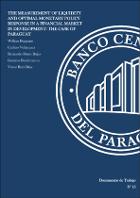| dc.creator | Bejarano, Willian |
| dc.creator | Velázquez, Carlino |
| dc.creator | Rojas, Bernardo Darío |
| dc.creator | Biedermann, Gustavo |
| dc.creator | Ruíz Díaz, Victor |
| dc.date.accessioned | 2020-12-23T17:59:29Z |
| dc.date.available | 2020-12-23T17:59:29Z |
| dc.date.created | 2012-06-01 |
| dc.date.issued | 2012-06-01 |
| dc.identifier.citation | Adrian, T. y Song Shin, Hyun (2007). “Liquidity and Leverage”. Paper presented at the Financial Cycles, Liquidity, and Securitization Conference hosted by the International Monetary Fund. Washington, DC- April 18, 2008. |
| dc.identifier.citation | Adrian, T. y Song Shin, Hyun (2008). “Liquidity, Monetary Policy and Financial Cycles”. Paper prepared for Current Issues in Economics and Finance. Federal Reserve Bank of New York. Volume 14, Number 1. Issued in January/February 2008. |
| dc.identifier.citation | Allen W. (2007). “Metas de la Inflación: la Experiencia Británica”. Centro de Estudios Monetarios Latinoamericanos (CEMLA). |
| dc.identifier.citation | Berg, A.; Karam, P.; Laxton, D. (2006). “A practical model-based approach to monetary policy analysis-Overview”. IMF Working Paper 06/80. |
| dc.identifier.citation | Bernanke B. and Gertler M., (2001). “Should Central Banks Respond to Movements in Asset Prices”. The American Economic Review. |
| dc.identifier.citation | Bernanke B. and Blinder A.,( 1992). “The Federal Rate and the Channels of Monetary Transmission”. The American Economic Review. |
| dc.identifier.citation | Çağlayan, E. and Astar, M. (2010). “Taylor Rule: Is it an Applicable Guide for Inflation Targeting Countries?”. Journal of Money, Investment and Banking, issue 18 (2010). © EuroJournals Publishing. |
| dc.identifier.citation | Corvalán J. (2012). “Monetary Policy and Macroprudential Measures”. Central Bank of Paraguay. |
| dc.identifier.citation | De Gregorio, J., (2006). “Esquema de Metas de Inflación en Economías Emergentes”. Central Bank of Chile. |
| dc.identifier.citation | Fernández, A.; et al. (1999). “Política Monetaria: su Eficacia y Enfoques Alternativos”. Ed. Ac. ch. 2. |
| dc.identifier.citation | Freedman, C. (1994). “The Use of Indicators and of the Monetary Conditions Index in Canada”. Eds. In Baliño, T. J. T., y Cottarelli, C. Frameworks for Monetary Stability: Policy Issues and Country Experiences. Washington D.C., US, International Monetary Fund. ch. 18. |
| dc.identifier.citation | Gustalle Gill, J. and Heisecke, C. (2011). “Adopción de Metas de Inflación en Paraguay: Una Evaluación”. Central Bank of Paraguay. |
| dc.identifier.citation | Hammond, G. (2011). “State of the art of inflation targeting”. Centre for Central Banking Studies, Bank of England. |
| dc.identifier.citation | Staff team (2011). “Financial System Stability Assessment - Update”. IMF staff country report 11/198, International Monetary Fund. |
| dc.identifier.citation | Sterne, G. (2002). “Inflation target in a global context”. Central Banking, Analysis, and Economic Policies Book Series, in: Norman Loayza & Raimundo Soto & Norman Loayza (Series Editor) & Klaus Schmidt-Hebbel (Series Editor) (ed.), Inflation Targeting: Desing, Performance, Challenges, edition 1, volume 5, chapter 2, pages 023-078 Central Bank of Chile. |
| dc.identifier.citation | Taylor J., (1993). “Discretion Versus Policy Rules in Practice”. Stanford University, Stanford. |
| dc.identifier.uri | http://repositorio.bcp.gov.py/handle/123456789/125 |
| dc.description.abstract | This paper explains the relationship between monetary policy decisions and the liquidity indicators. To this end, a Taylor Rule is estimated and transitory deviations from the rule are related to a selected liquidity indicator. Results suggest that liquidity in the Paraguayan economy is intimately linked with how loose or tight monetary policy is relative to a Taylor Rule benchmark. Historical data for Paraguay has shown that high (low) liquidity in the financial system is correlated with negative (positive) Taylor residuals. |
| dc.format.extent | 19 páginas |
| dc.format.mimetype | application/pdf |
| dc.language.iso | eng |
| dc.publisher | BCP |
| dc.relation.ispartof | Documentos de Trabajo |
| dc.relation.ispartofseries | Documento de Trabajo |
| dc.relation.isversionof | Documento de Trabajo; N° 15 |
| dc.rights.uri | http://creativecommons.org/publicdomain/zero/1.0/ |
| dc.subject | LIQUIDEZ |
| dc.subject | REGLA DE TAYLOR |
| dc.subject | INFLACIÓN |
| dc.subject | OBJETIVO DE INFLACIÓN |
| dc.title | The measurement of liquidity and optimal monetary policy response in a financial market in development: the case of Paraguay |
| dc.title.alternative | La medición de la liquidez y la respuesta óptima de la política monetaria en un mercado financiero en desarrollo: el caso de Paraguay |
| dc.type | Working Paper |
| dc.subject.keyword | LIQUIDITY |
| dc.subject.keyword | TAYLOR RULE |
| dc.subject.keyword | INFLATION |
| dc.subject.keyword | INFLATION TARGETING |
| dc.rights.accessRights | Open Access |
| dc.type.spa | Documento de Trabajo |
| dc.type.hasversion | Published Version |
| dc.rights.cc | CC0 1.0 Universal |
| dc.rights.spa | Acceso abierto |
 This work is licensed under a Creative Commons Reconocimiento-NoComercial 4.0.This document has been deposited by the author (s) under the following certificate of deposit
This work is licensed under a Creative Commons Reconocimiento-NoComercial 4.0.This document has been deposited by the author (s) under the following certificate of deposit

